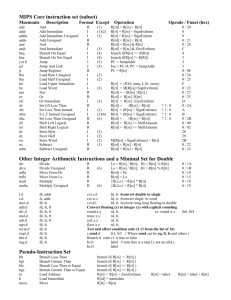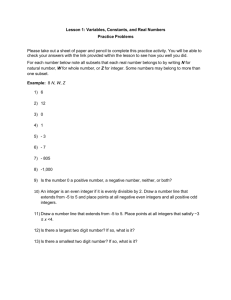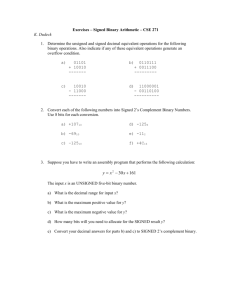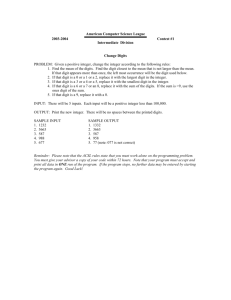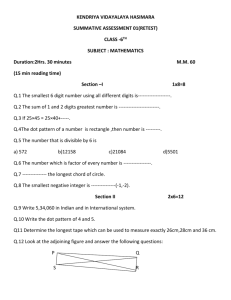ppt - University of North Carolina at Chapel Hill
advertisement
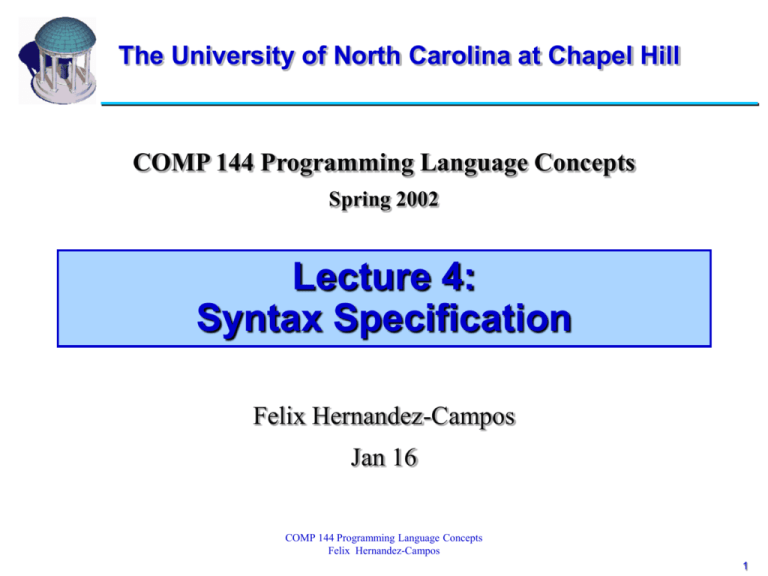
The University of North Carolina at Chapel Hill
COMP 144 Programming Language Concepts
Spring 2002
Lecture 4:
Syntax Specification
Felix Hernandez-Campos
Jan 16
COMP 144 Programming Language Concepts
Felix Hernandez-Campos
1
Phases of Compilation
COMP 144 Programming Language Concepts
Felix Hernandez-Campos
2
Syntax Analysis
• Syntax:
– Webster’s definition: 1 a : the way in which linguistic
elements (as words) are put together to form constituents
(as phrases or clauses)
• The syntax of a programming language
– Describes its form
» i.e. Organization of tokens (elements)
– Formal notation
» Context Free Grammars (CFGs)
COMP 144 Programming Language Concepts
Felix Hernandez-Campos
3
Review: Formal definition of tokens
• A set of tokens is a set of strings over an alphabet
– {read, write, +, -, *, /, :=, 1, 2, …, 10, …, 3.45e-3, …}
• A set of tokens is a regular set that can be defined by
comprehension using a regular expression
• For every regular set, there is a deterministic finite
automaton (DFA) that can recognize it
– i.e. determine whether a string belongs to the set or not
– Scanners extract tokens from source code in the same way
DFAs determine membership
COMP 144 Programming Language Concepts
Felix Hernandez-Campos
4
Review: Regular Expressions
• A regular expression (RE) is:
– A single character
– The empty string,
– The concatenation of two regular expressions
» Notation: RE1 RE2 (i.e. RE1 followed by RE2)
– The union of two regular expressions
» Notation: RE1 | RE2
– The closure of a regular expression
» Notation: RE*
» * is known as the Kleene star
» * represents the concatenation of 0 or more strings
COMP 144 Programming Language Concepts
Felix Hernandez-Campos
5
Review: Token Definition Example
• Numeric literals in Pascal
– Definition of the token unsigned_number
digit 0 | 1 | 2 | 3 | 4 | 5 | 6 | 7 | 8 | 9
unsigned_integer digit digit*
unsigned_number unsigned_integer ( ( . unsigned_integer ) | )
( ( e ( + | – | ) unsigned_integer ) | )
• Recursion is not allowed!
COMP 144 Programming Language Concepts
Felix Hernandez-Campos
6
Exercise
digit 0 | 1 | 2 | 3 | 4 | 5 | 6 | 7 | 8 | 9
unsigned_integer digit digit*
unsigned_number unsigned_integer ( ( . unsigned_integer ) | )
( ( e ( + | – | ) unsigned_integer ) | )
• Regular expression for
– Decimal numbers
number …
COMP 144 Programming Language Concepts
Felix Hernandez-Campos
7
Exercise
digit 0 | 1 | 2 | 3 | 4 | 5 | 6 | 7 | 8 | 9
unsigned_integer digit digit*
unsigned_number unsigned_integer ( ( . unsigned_integer ) | )
( ( e ( + | – | ) unsigned_integer ) | )
• Regular expression for
– Decimal numbers
number ( + | – | ) unsigned_integer ( ( unsigned_integer ) | )
COMP 144 Programming Language Concepts
Felix Hernandez-Campos
8
Exercise
digit 0 | 1 | 2 | 3 | 4 | 5 | 6 | 7 | 8 | 9
unsigned_integer digit digit*
unsigned_number unsigned_integer ( ( . unsigned_integer ) | )
( ( e ( + | – | ) unsigned_integer ) | )
• Regular expression for
– Identifiers
identifier …
COMP 144 Programming Language Concepts
Felix Hernandez-Campos
9
Exercise
digit 0 | 1 | 2 | 3 | 4 | 5 | 6 | 7 | 8 | 9
unsigned_integer digit digit*
unsigned_number unsigned_integer ( ( . unsigned_integer ) | )
( ( e ( + | – | ) unsigned_integer ) | )
• Regular expression for
– Identifiers
identifier letter ( letter | digit | )*
letter a | b | c | … | z
COMP 144 Programming Language Concepts
Felix Hernandez-Campos
10
Context Free Grammars
• CFGs
– Add recursion to regular expressions
» Nested constructions
– Notation
expression identifier | number | - expression
| ( expression )
| expression operator expression
operator + | - | * | /
» Terminal symbols
» Non-terminal symbols
» Production rule (i.e. substitution rule)
terminal symbol terminal and non-terminal symbols
COMP 144 Programming Language Concepts
Felix Hernandez-Campos
11
Backus-Naur Form
• Backus-Naur Form (BNF)
– Equivalent to CFGs in power
– CFG
expression identifier | number | - expression
| ( expression )
| expression operator expression
operator + | - | * | /
– BNF
expression identifier | number | - expression
| ( expression )
| expression operator expression
operator + | - | * | /
COMP 144 Programming Language Concepts
Felix Hernandez-Campos
12
Extended Backus-Naur Form
• Extended Backus-Naur Form (EBNF)
– Adds some convenient symbols
» Union
» Kleene star
» Meta-level parentheses
|
*
()
– It has the same expressive power
COMP 144 Programming Language Concepts
Felix Hernandez-Campos
13
Extended Backus-Naur Form
• Extended Backus-Naur Form (EBNF)
– It has the same expressive power
BNF
digit 0
digit 1
…
digit 9
unsigned_integer digit
unsigned_integer digit unsigned_integer
EBNF
digit 0 | 1 | 2 | 3 | 4 | 5 | 6 | 7 | 8 | 9
unsigned_integer digit digit*
COMP 144 Programming Language Concepts
Felix Hernandez-Campos
14
Derivations
• A derivation shows how to generate a syntactically
valid string
– Given a CFG
– Example:
» CFG
expression identifier | number | - expression
| ( expression )
| expression operator expression
operator + | - | * | /
» Derivation of
slope * x + intercept
COMP 144 Programming Language Concepts
Felix Hernandez-Campos
15
Derivation Example
• Derivation of
slope * x + intercept
expression expression operator expression
expression operator intercept
expression + intercept
expression operator expression + intercept
expression operator x + intercept
expression * x + intercept
slope * x + intercept
expression * slope * x + intercept
» Identifiers were not derived for simplicity
COMP 144 Programming Language Concepts
Felix Hernandez-Campos
16
Parse Trees
• A parse is graphical representation of a derivation
• Example
COMP 144 Programming Language Concepts
Felix Hernandez-Campos
17
Ambiguous Grammars
• Alternative parse tree
– same expression
– same grammar
• This grammar is ambiguous
COMP 144 Programming Language Concepts
Felix Hernandez-Campos
18
Designing unambiguous grammars
• Specify more grammatical structure
– In our example, left associativity and operator precedence
» 10 – 4 – 3 means (10 – 4) – 3
» 3 + 4 * 5 means 3 + (4 * 5)
COMP 144 Programming Language Concepts
Felix Hernandez-Campos
19
Example
• Parse tree for 3 + 4 * 5
• Exercise: parse tree for
- 10 / 5 * 8 – 4 - 5
COMP 144 Programming Language Concepts
Felix Hernandez-Campos
20
Java Language Specification
• Available on-line
– http://java.sun.com/docs/books/jls/second_edition/html/j.tit
le.doc.html
• Examples
– Comments:
http://java.sun.com/docs/books/jls/second_edition/html/lex
ical.doc.html#48125
– Multiplicative Operators:
http://java.sun.com/docs/books/jls/second_edition/html/ex
pressions.doc.html#239829
– Unary Operators:
http://java.sun.com/docs/books/jls/second_edition/html/ex
pressions.doc.html#4990
COMP 144 Programming Language Concepts
Felix Hernandez-Campos
21
Reading Assignment
• Scott’s Chapter 2
– Section 2.1.2
– Section 2.1.3
• Java language specification
– Chapter 2 (Grammars)
– Glance at chapter 3
– Glance at sections 15.17, 15.18 and 15.15
COMP 144 Programming Language Concepts
Felix Hernandez-Campos
22
